Catégorie : Non classé
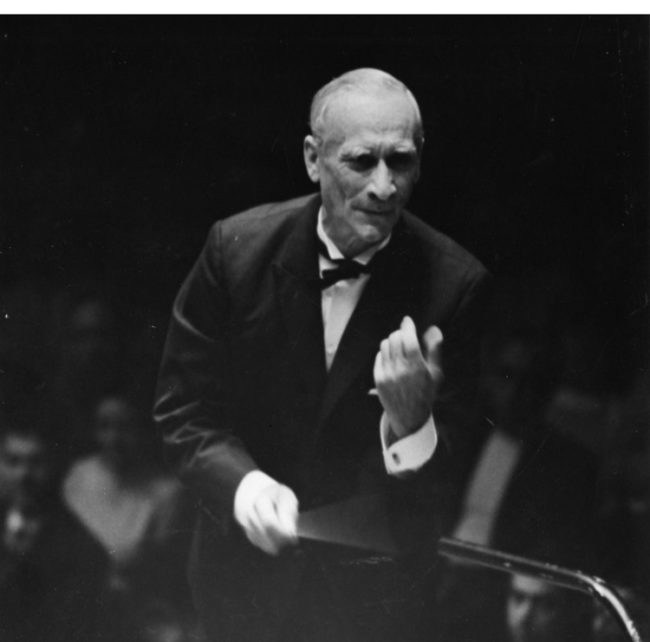
Karel Ančerl – Boston Symphony Orchestra (BSO)
Smetana Ma Vlast IV: Z českých luhů a hájů (Des forêts et prairies de Bohême – From Bohemia’s fields and woods), V: Tábor, VI: Blanik
Berkshire Festival – Tanglewood Shed August 8, 1969
Source: Bande/Tape 19 cm/s / 7.5 ips
Suite à plusieurs demandes, voici la deuxième partie du concert de 1969 consacré à la première audition intégrale par le BSO du cycle Ma Vlast de Smetana.
Peu après le debut de cette deuxième partie, un violent orage a éclaté sur les monts Berkshire et on peut malheureusement l’entendre à plusieurs reprises sur des durées assez longues, seule l’audition de Tábor restant relativement épargnée.
Le concert n’en a pas moins été un grand succès, comme le montrent les applaudissements et les nombreux rappels à la fin, ainsi que les spectateurs tapant des pieds, qui ajoutent au bruit du tonnerre comme le remarque par un trait d’ humour le présentateur William Pierce.
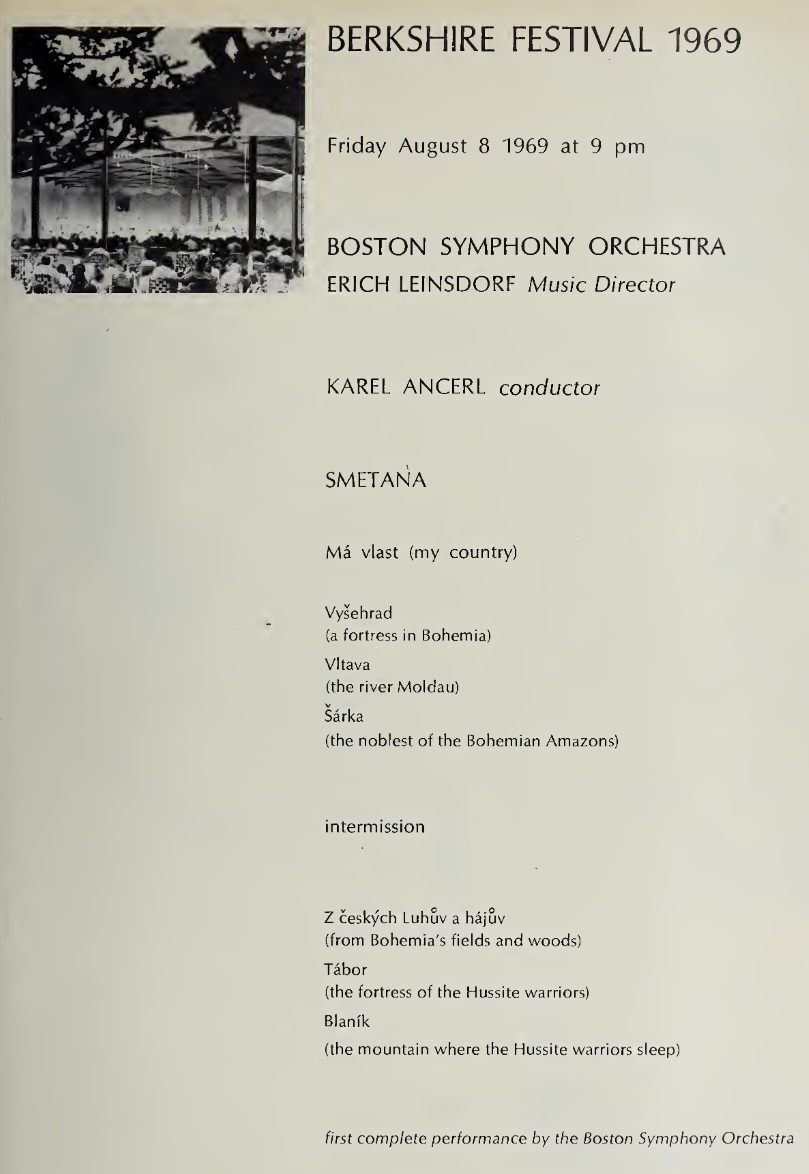
Further to several requests, here is the second part of the 1969 concert dedicated to the first complete performance by the BSO of Smetana’s cycle Ma Vlast.
Shortly after the beginning of this second part, a violent thunderstorm started over the Berkshires and unfortunately, it can be heard over several rather long stretches of time, only the listening of Tábor remaining relatively spared.
The concert was nevertheless a great success, as shown by the applause and the many recalls at the end, as well as the public foot bumping, described with tongue-in-cheek humor by announcer William Pierce as adding to the thunder.

Gerhard Hüsch & Hanns-Udo Müller
Source: 33t/LP World Records (Retrospect Series) SH 295
Enregistrement/ Recording: 1935
London Abbey Road Studio n°3: January 31: N° 1-6, 8-10 & 12
February 2: N° 13-18; February 5: N° 7, 11 & 20
Berlin March 22: N° 19
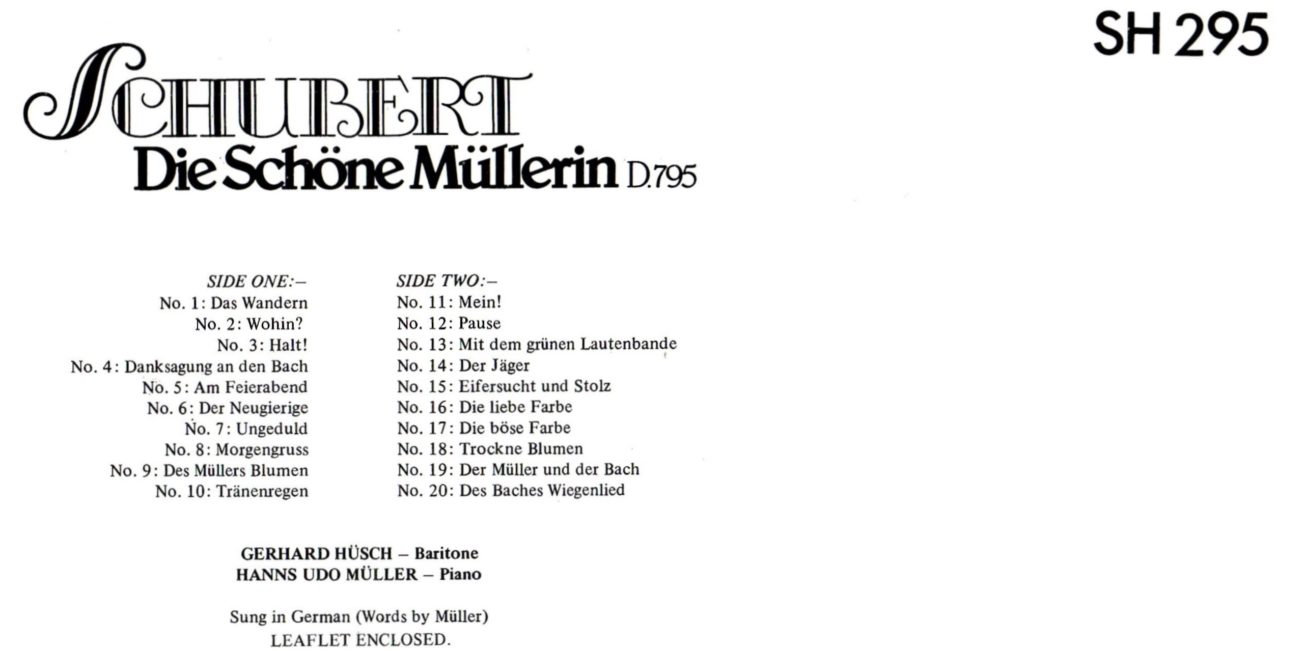
Gerhard Hüsch (1901-1984) formait avec le pianiste Hanns-Udo Müller (1905-1943) un duo d’une rare homogénéité. Leurs enregistrements datent tous d’avant 1941, et Hüsch n’enregistrera quasiment plus par la suite, si bien que tous les témoignages de son art le représentent à son sommet vocal. Cet enregistrement de «Die Schöne Müllerin» de 1935 est d’une telle perfection qu’il constitue depuis sa sortie une référence, reléguant dans l’ombre l’enregistrement intégral fait par Hans Duhan et Ferdinand Foll en 1928. L’interprétation a toute la densité souhaitable, tout en reflétant les suggestions du poète Wilhelm Müller qui ouvrent et referment le cycle (Der Dichter, als Prolog, et Der Dichter als Epilog, que Schubert n’a pas mises en musique): il ne faut pas prendre trop au tragique ce qui n’est qu’une fiction.
L’édition en microsillon par le label World Records d’Anthony Griffith à partir de pressages vinyle des matrices métalliques des 78 tours restitue fidèlement l’interprétation et l’ambiance de salle, si bien que l’on entend notamment la différence de prise de son pour le Lied n°19 «Der Müller und der Bach», ré-enregistré en mars à Berlin.
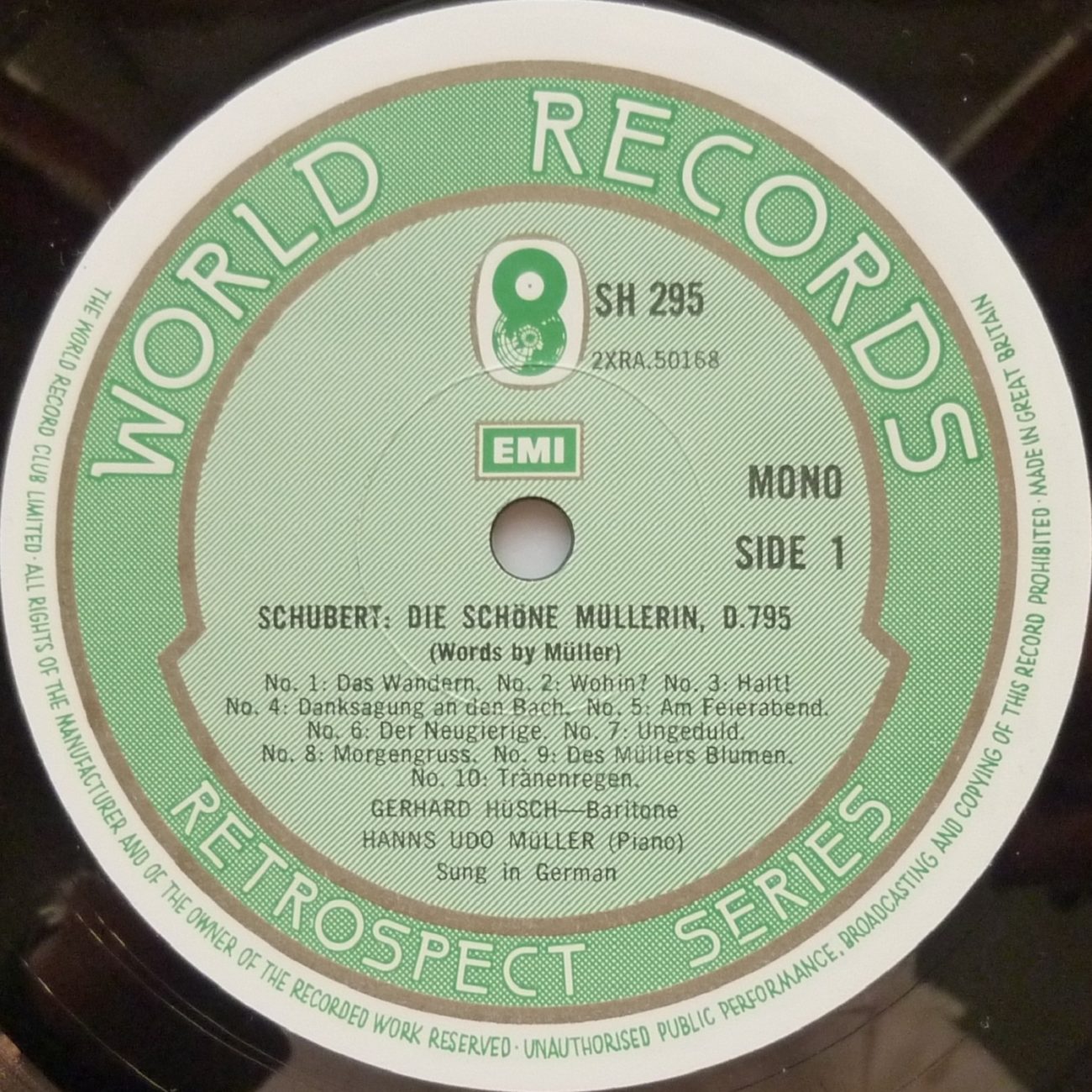

Gerhard Hüsch (1901-1984) together with pianist Hanns-Udo Müller (1905-1943), this was an exceptionally homogeneous duet. Their recordings were all made before 1941, and Hüsch was to record almost nothing afterwards, so that all the testimonies of his art show him at his vocal best. This 1935 recording of «Die Schöne Müllerin» is so perfect that it is a reference since it was issued, which meant also that the complete recording made by Hans Duhan and Ferdinand Foll in 1928 fell into oblivion. The performance has all the required density, while reflecting the suggestions by poet Wilhelm Müller which open and close the cycle (Der Dichter, als Prolog, and Der Dichter, als Epilog, not set to music by Schubert): what is only a story should not be taken too tragically.
The LP issue by Anthony Griffith’s label World Records from vinyl pressings of 78rpm metal masters is true to the performance and to the room ambiance, so that even the difference in sound for Lied n°19 «Der Müller und der Bach», re -recorded in March in Berlin, is clear for the listener.

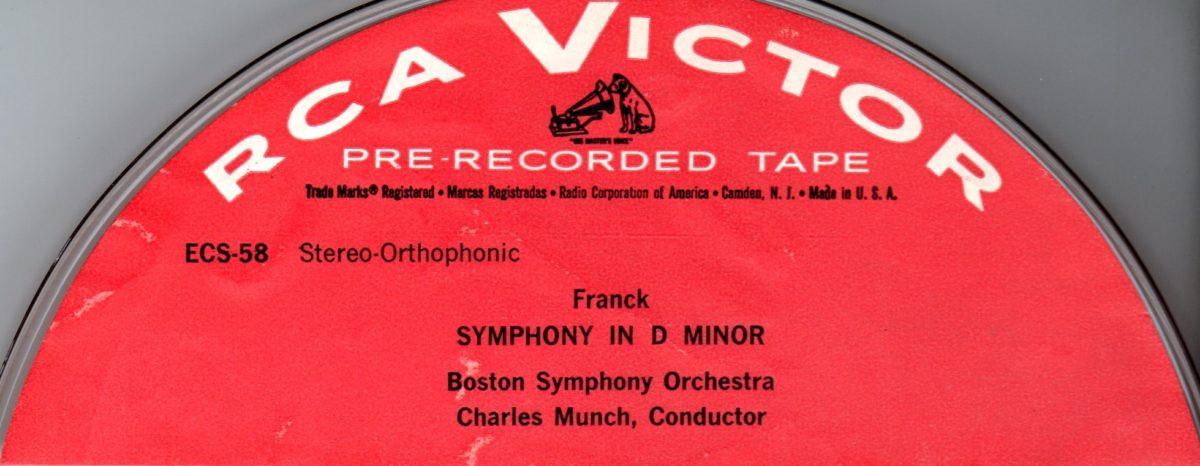
I: Lento-Allegro non troppo – II: Allegretto – III: Allegro non troppo
Charles Munch – Boston Symphony Orchestra
Symphony Hall – March 11, 1957
Source: Bande 2 pistes /2-track Tape: RCA ECS-58
Charles Munch était le chef de l’inspiration spontanée: il y avait beaucoup de différences entre ses interprétations d’une même œuvre. Par contre, la passion qu’il mettait dans ses concerts ne se retrouvait qu’en partie dans ses disques, souvent considérés comme moins satisfaisants.
Sa personnalité le conduisait également à des exagérations enthousiasmantes en concert, mais parfois discutables à l’audition des enregistrements publics. C’est le cas de la Symphonie de Franck, pour laquelle on dispose d’une bande captée en concert le 9 mars 1957, soit deux jours avant l’enregistrement officiel (coffret «Charles Munch conducts A Treasury of French Music» 6CD WHRA-6027). En public, Munch pousse de manière spectaculaire les contrastes de tempi et de dynamique avec pour résultat paradoxal des minutages beaucoup plus élevés*, alors que l’enregistrement de studio, tout en conservant la patte caractéristique de Munch et son inspiration, serait à choisir de préférence.
L’année 1957 voit chez RCA une amélioration de la prise de son stéréophonique, avec l’utilisation de trois microphones (gauche, droite et centre) et d’une bande magnétique trois pistes. Pour une écoute à deux canaux, les signaux des micro de gauche et de droite sont affectés à chacun des canaux respectifs comme pour une stéréo normale, et le signal du micro central est ajouté aux deux canaux. Cette technique, qui sera également adoptée sous peu par Columbia permet d’améliorer la définition ainsi que la répartition spatiale pour une écoute plus proche du concert. Elle est décrite en détail par Bert Whyte dans sa recension de cette bande ECS-58 dans «Hi-fi & Music Review» de février 1958 (page 91). Pour la lire , cliquer ICI.
*Concert: I: 18’; II: 9’53; III:10’28 – Enregistrement RCA: I: 16’55; II: 9’23; III: 10’10


Charles Munch was the conductor for spontaneous inspiration: he would give many different interpretations of a same work. On the other hand, the passion in his concerts was only partly to be found in his commercial discs, often considered as less satisfactory.
His personality led him too to thrilling exaggerations in his concerts, but sometimes objectionable when listening to live recordings. It is the case with Franck’s Symphony, for which we have a concert tape recorded on March 9, 1957, namely two days before the official recording (in Boxset «Charles Munch conducts A Treasury of French Music» 6CD WHRA-6027). Live, Munch spectacularly pushes to the limit the contrasts of tempi and of dynamics, with the paradoxical result of much higher timings*, whereas the studio recording, while keeping the typical Munch’s touch and inspiration, would be a more obvious choice.
1957 brought an improvement to the RCA stereo recordings, with the use of three microphones (left, right and centre) and of a three-track tape. For two-channel reproduction, the signals of the left and right mikes are fed to the respective left and right channels as in normal stereo, and the signal of the central mike is added to both channels. This technique, which was soon to be used also by Columbia, allows to increase the definition and the spatial spreading for a listening that is closer to the concert. It is described in details by Bert Whyte in his review of this tape ECS-58 in «Hi-fi & Music Review» of February 1958 (page 91). To read it, please click HERE.
*Concert: I: 18’; II: 9’53; III:10’28 – RCA Recording: I: 16’55; II: 9’23; III: 10’10
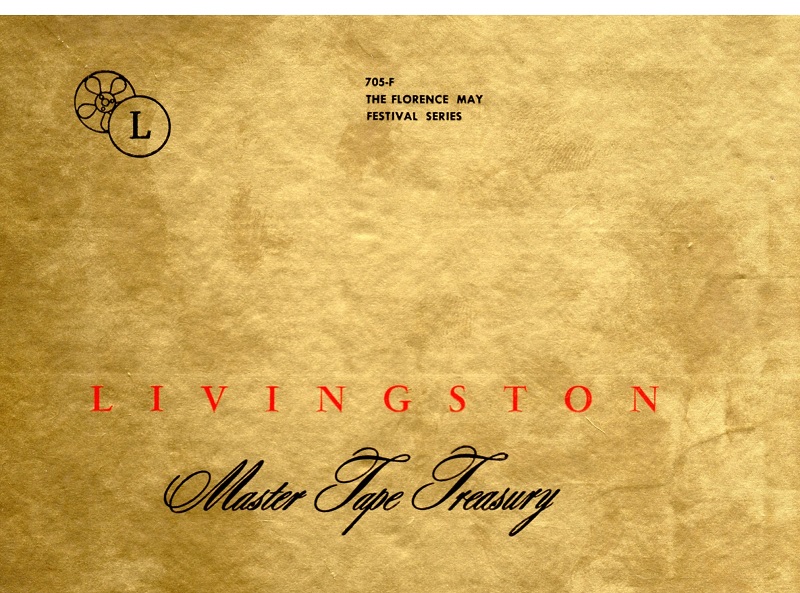
Vittorio Gui – Orchestra del Maggio Musicale Fiorentino
Schubert Symphonie n°8 D759
Rossini Guillaume Tell Ouverture
Brahms Akademische Festouvertüre Op.80
Massenet-Scènes Alsaciennes: n°3 Sous les Tilleuls
Enr/Rec: Teatro Comunale di Firenze – May – June 1953 Stereo
Source: Bande/Tape Audiosphere 701-BN & Livingston 705F
Le Mai Musical Florentin de 1953 (XVI Maggio Musicale Fiorentino) est resté célèbre en raison des représentations de la Medea de Cherubini avec Maria Callas sous la direction de Vittorio Gui.
Fait moins connu, au cours de ce Festival, ont été réalisés les premiers enregistrements stéréophoniques commerciaux en Europe, sous la direction de Vittorio Gui, pour le label américain Livingston fondé par Ched Smiley.
Le directeur artistique de cette production était le chef Hans Wolf (Hamburg 1912- Seattle 2005). Il a étudié notamment avec Heinrich Schenker en 1933 et 1934 et a poursuivi ensuite des études à Vienne. Comme Marcel Prawy dont il était l‘ami, Il s’est engagé dans l’armée américaine en 1943, a obtenu la nationalité américaine et a été envoyé à Vienne au printemps 1945. Avant de s’installer aux Etats-Unis en 1952, il a fait des enregistrements pour le label Remington et un orchestre dénommé «Austrian Symphony Orchestra« (qui était en fait le Niederösterreichisches Tonkünstler Orchester) entre 1950 et février 1952, en tant que chef d’orchestre (Beethoven Symphonie n°5, Brahms Symphonie n°2, Franck Symphonie etc…). Il a également été producteur associé avec Marcel Prawy, pour les enregistrements avec Fritz Busch avec le même orchestre (Haydn Symphonie n°101, Beethoven Symphonies n°3 et 8) pour lesquels l’ingénieur du son était Hans Sachs de la Radio autrichienne RAVAG) et, fait notable avec Vittorio Gui (Mendelssohn: Symphonie n°5 et Ouverture «Les Hébrides», ainsi qu’un disque d’ouvertures).

Hans Wolf – Marcel Prawy – Fritz Busch – Hans Sachs – Wien Oktober 1950
Par ailleurs, le label Livingston était à l’époque engagé dans des recherches de stéréophonie expérimentale, notamment avec le concept de disque à double sillon d’Emery Cook, pour lequel Livingston a commercialisé un bras de lecture « Binaural Arm »:
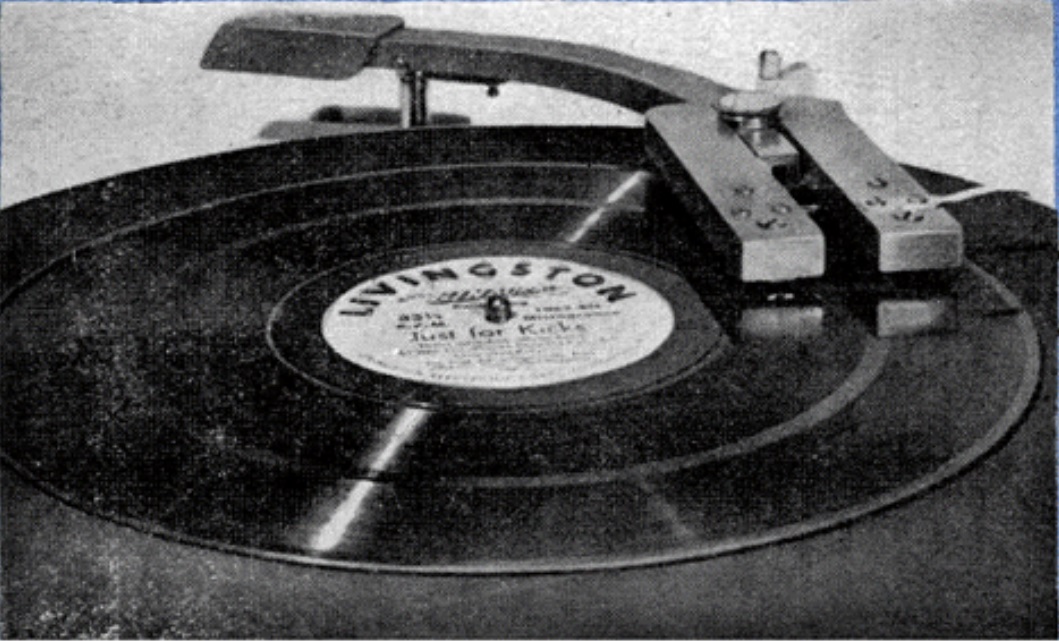
Livingston Binaural Arm
Le nouveau projet de Livingston qui a vu le jour en 1953 était la commercialisation en stéréophonie, sur bandes magnétiques, d’une importante série d’ enregistrements orchestraux faits à Florence sous la direction de Vitorio Gui au cours du Mai Musical Florentin qui a eu lieu entre le 7 mai et le 29 juin 1953. Livingston n’était pas le seul avec un tel projet, mais ses enregistrements orchestraux en stéréo ont précédé ceux d’ AV-Tapes Libraries (Sibelius: Cincinnati SO Thor Johnson enregistré en novembre 1953).
Cinq bandes magnétiques référencées 701 à 705 publiées par Livingston/Audiosphere ont été annoncées dans les numéros de juin et d’août 1954 de la revue Tape Recordings, après avoir fait l’objet au mois de mars d’une présentation au public à Cleveland (Cleveland Chapter 18th Symposium «Stereo Symposium») sous la forme d’émissions radiophoniques FM expérimentales en stéréo.
Lors des séances d’enregistrement à Florence, deux jours ont été consacrés à la mise en place des microphones et à la balance de l’orchestre, le montage des bandes a été réalisé sur place, et les enregistrements ont fait l’objet d’une écoute en vue de leur approbation.
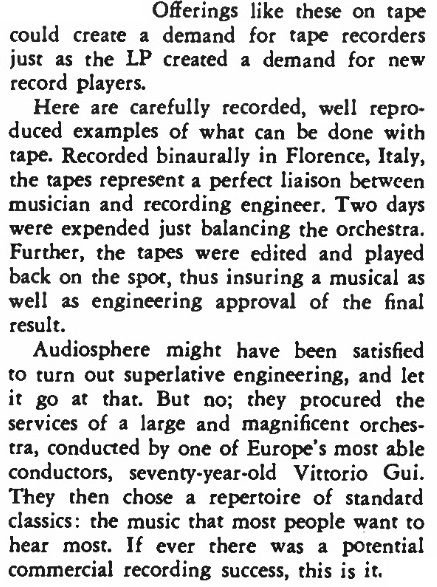
Presentation (Tape Recordings: June 1954)
Dans un article intitulé «Tape makes it easier» paru dans le numéro d’avril 1955 de la Revue «Tape Recordings«, Hans Wolf a dévoilé sa conception personnelle des enregistrements sur bande magnétique et sur le montage, et il a raconté la visite d‘Heinrich Kralik, musicologue et Directeur du département musical de la Radio Autrichienne RAVAG, lors du montage des enregistrements de Vittorio Gui dans une petite salle du Teatro Comunale. Pour le lire, cliquer ICI.
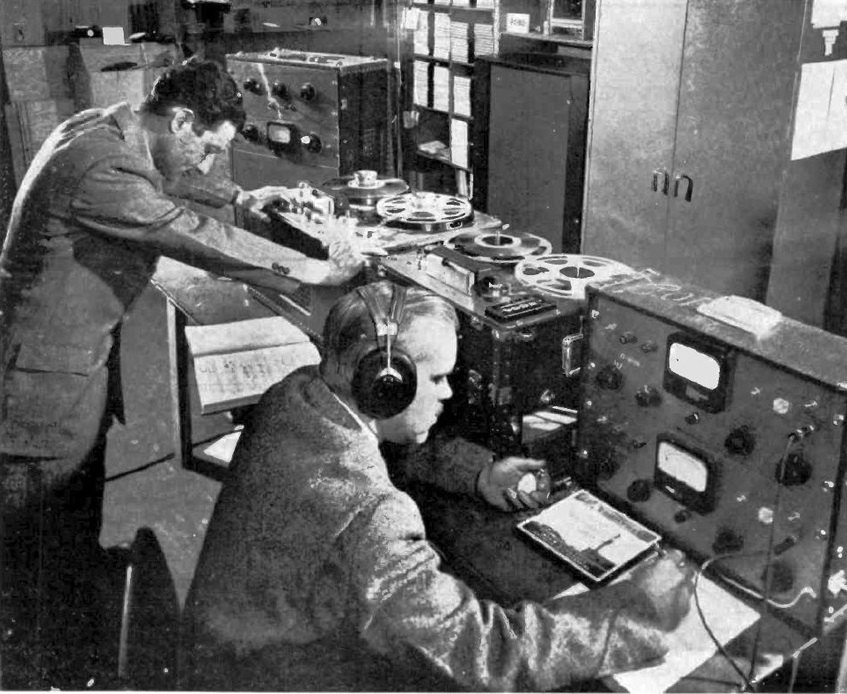
Hans Wolf & Ched Smiley
Les annonces de publications de bandes magnétiques stéréophoniques par de petites firmes (Livingston/Audiosphere et AV Tapes Library) ont créé une forte incitation pour les grands labels et en tout premier lieu RCA qui a annoncé dès juillet 1954 dans la revue High Fidelity sa première publication d’une bande magnétique en stéréo: Strauss Also sprach Zarathustra Chicago SO Fritz Reiner, enregistrement du 6 mars 1954.
Par la suite, les publications pionnières de Livingston sont progressivement tombées dans l’oubli jusqu’à la réédition en 2014 des enregistrements de Vittorio Gui sous le propre label du Festival «Historical Maggio Live» (2CD OF 003).

Bande /Tape Audiosphere BN701

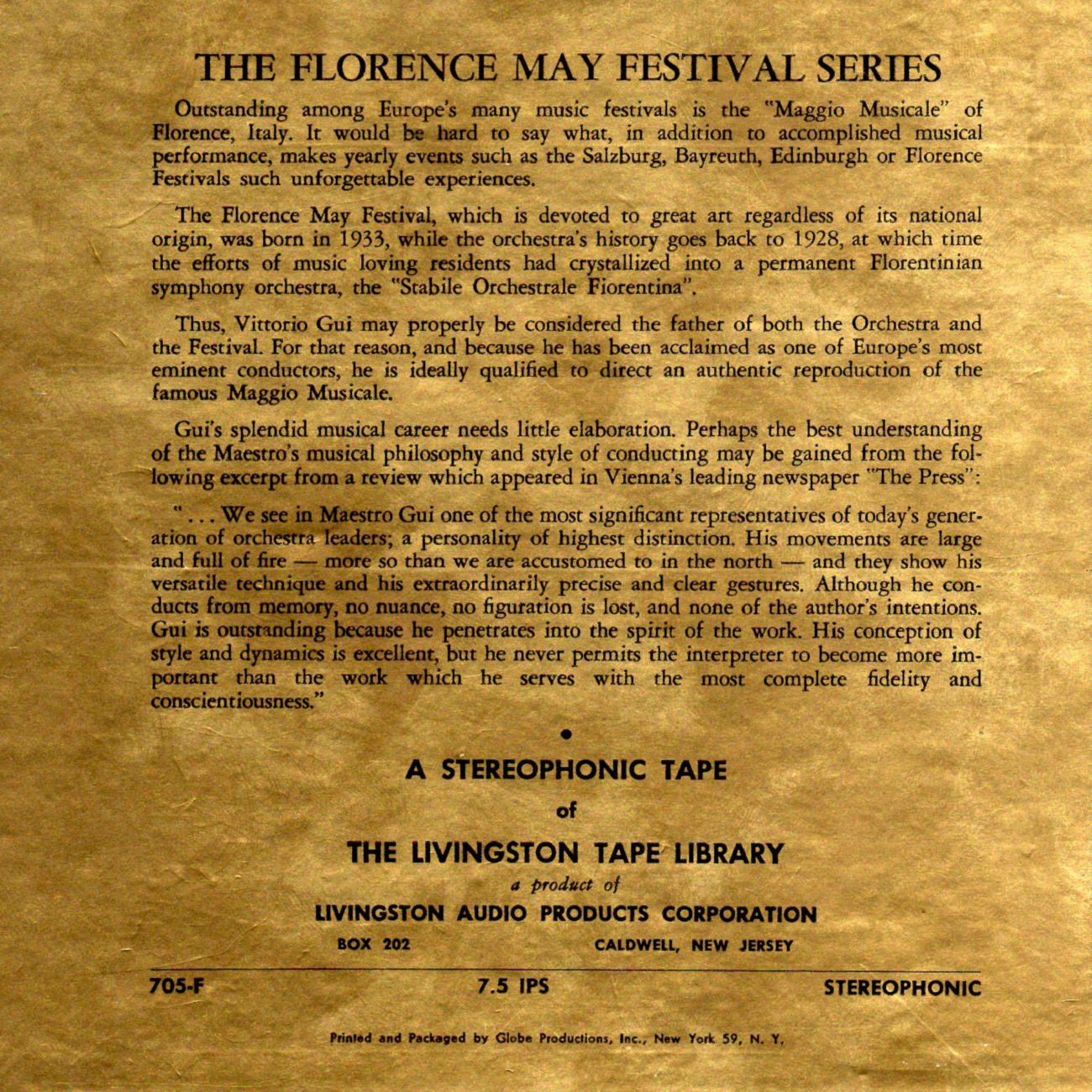
Bande /Tape Livingston 705-F

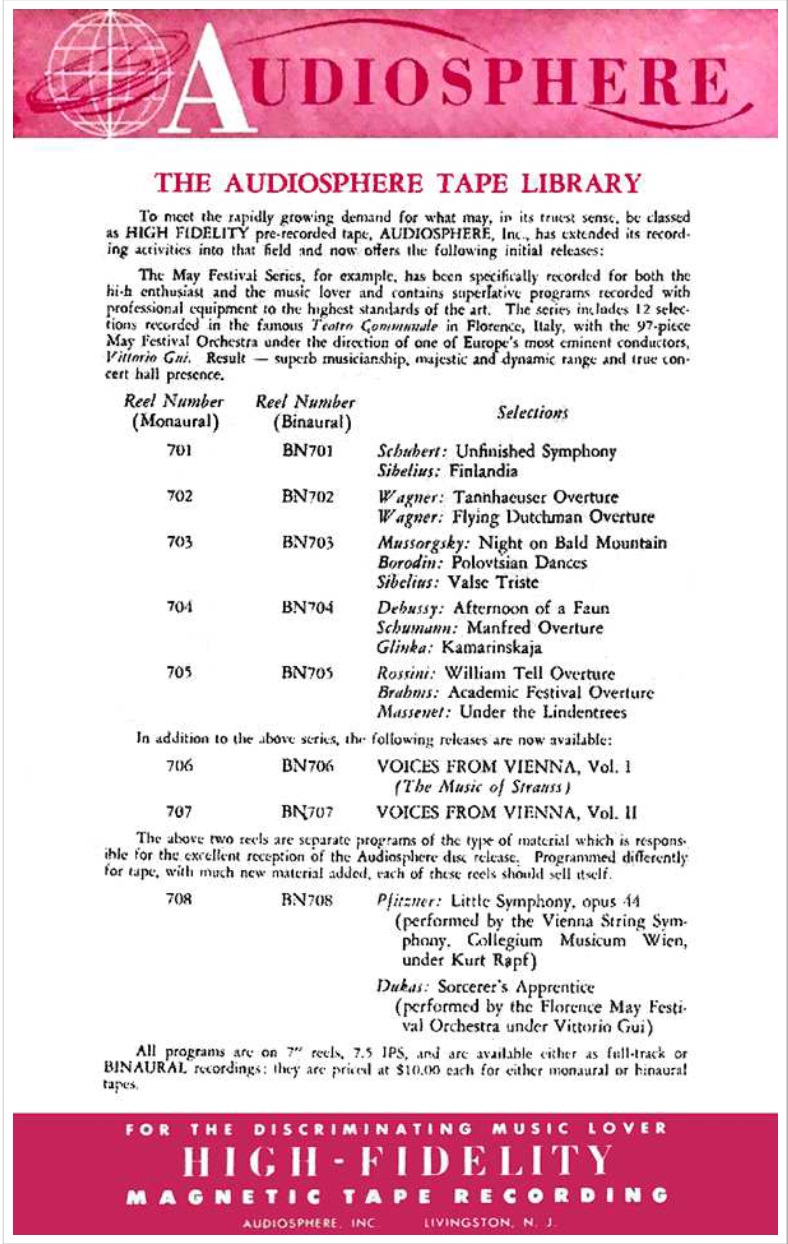
Audiosphere Catalog December 1954
The 1953 Florence May Festival (XVI Maggio Musicale Fiorentino) has remained memorable because of the performances of Cherubini’s Medea with Maria Callas conducted by Vittorio Gui.
But it is much lesser known that during this Festival, the first commercial stereophonic recordings in Europe were made with conductor Vittorio Gui, for the US Livingston label founded by Ched Smiley.
The musical producer was conductor Hans Wolf (Hamburg 1912- Seattle 2005). He studied among others with Heinrich Schenker in 1933 and 1934 and then further studied in Vienna. In the same way as Marcel Prawy who was his friend, he joined the US Army in 1943, became a US citizen and was sent to Vienna in the Spring of 1945. Before settling in the USA in 1952, he made recordings for the Remington label and the so-called «Austrian Symphony Orchestra « (which was in fact the Niederösterreichisches Tonkünstler Orchester) between 1950 and February 1952, as a conductor (Beethoven Symphonie n°5, Brahms Symphonie n°2, Franck Symphonie etc…). He was also the assisting producer to Marcel Prawy, for the recordings with Fritz Busch with the same orchestra (Haydn Symphony n°101, Beethoven Symphonies n°3 and 8) for which the recording engineer was Hans Sachs from the Austrian Radio (RAVAG) and, also worth noting, with Vittorio Gui (Mendelssohn: Symphony n°5 and Overture «Hebriden», as well as a LP comprised of overtures).
On the other hand, the Livingston label was then involved in research in experimental stereophony, especially with Emery Cook’s double groove LP concept, for which Livingston sold a tone arm called « Binaural Arm »:
The new Livingston concept that materialized in 1953 was the commercialization on stereophonic magnetic tapes of an important series of recordings made in Florence under the direction of Vitorio Gui during the May Festival which took place between May 7 and June 29, 1953. Livingston was not the only one with such an idea, but its stereo orchestral recordings were made before those of AV-Tapes Libraries (Sibelius: Cincinnati SO Thor Johnson recorded November 1953).
Five magnetic tapes (Ref: 701 to 705) issued by Livingston/Audiosphere have been announced in the June and August 1954 issues of the review Tape Recordings, just after having been presented to the public in March in Cleveland (Cleveland Chapter 18th Symposium «Stereo Symposium») as experimental stereo FM broadcasts.
Two days of the recording sessions in Florence were used just balancing the orchestra and the tapes were edited and played back on the spot for approval .
In an article titled «Tape makes it easier» published in the April 1955 issue of the review «Tape Recordings«, Hans Wolf unveiled his personal ideas as to recording on magnetic tape and on editing, and he described the unexpected visit of Heinrich Kralik, musicologist and Director of the music department of the Austrian Radio RAVAG, during the editing of Vittorio Gui’s recordings in a small room of the Teatro Comunale. To read it, please click HERE.
The advertised publications of stereophonic magnetic papes by small labels (Livingston/Auduiosphere and AV Tapes Library) generated a strong incentive for the big record companies and in the first place RCA which advertised as early as July 1954 in the review High Fidelity the publication of its first stereo tape: Strauss Also sprach Zarathustra Chicago SO Fritz Reiner, recorded March 6, 1954.
Later on, the Livingston pioneer efforts progressively fell into oblivion until the 2014 re-issue of Vittorio Gui’s recordings by the in-house label «Historical Maggio Live» (2CD OF 003).
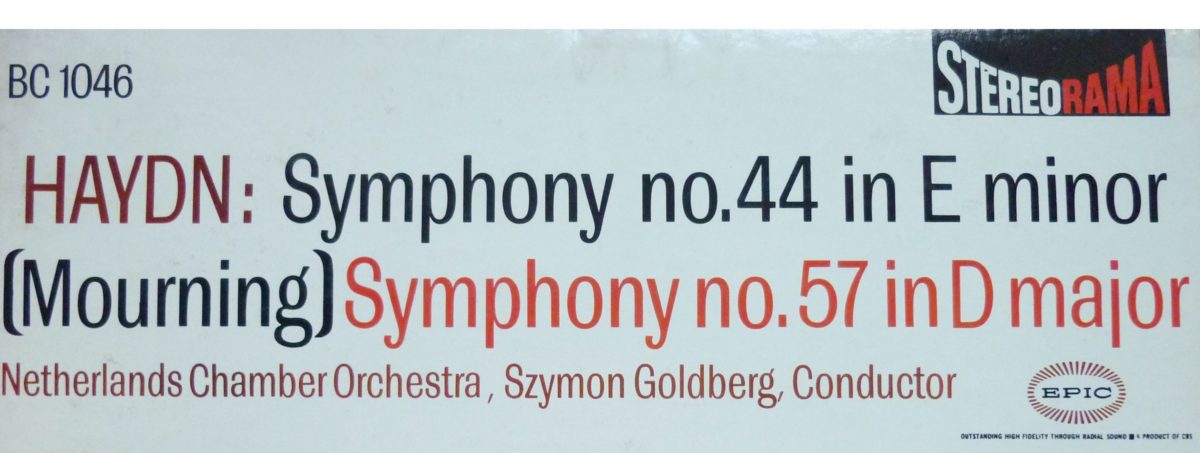
Szymon Goldberg Nederlands Kamerorkest (Netherlands Chamber Orchestra)
Enregistrement /Recording: Amsterdam Concertgebouw
Symphonie n°44: 22 – 23 September 1958
Symphonie n°57: 13 -15 October 1958
Source 33t/LP: Epic BC 1046 (1959)
Szymon Goldberg (1909-1993) a fondé le «Nederlands Kamerorkest» (NKO) en 1955, à la demande du gouvernement néerlandais, et il l’a dirigé jusqu’en 1979. Au cours des années 1970, il en a de plus en plus confié la direction à David Zinman. En dépit de la qualité de cet ensemble et de la longue période au cours de laquelle Goldberg l’a dirigé, peu d’enregistrements commerciaux ont été réalisés. Des enregistrements publics avec le NKO se trouvent fort heureusement dans le coffret Music & Arts CD-1223.
Paru en 1959, le disque Haydn, enregistré à l’origine par Philips, associe de manière pertinente deux des symphonies de la période «Sturm und Drang», avec une première discographique: la symphonie n°57. En ce qui concerne la symphonie n°44 (dite «Funèbre» ou «Trauer»), l’Adagio est, de manière surprenante, placé sur le disque en seconde position et le Menuetto en troisième position. Le texte de la pochette se contente de rapporter que « de récentes investigations conduites en Allemagne et en Autriche parmi les manuscrits semblent indiquer que l’intention de Haydn aurait pu être qu’elles soient jouées dans l’ordre inverse».
Les dates d’enregistrement proviennent de la discographie de Shuichiro Kawai (2012).
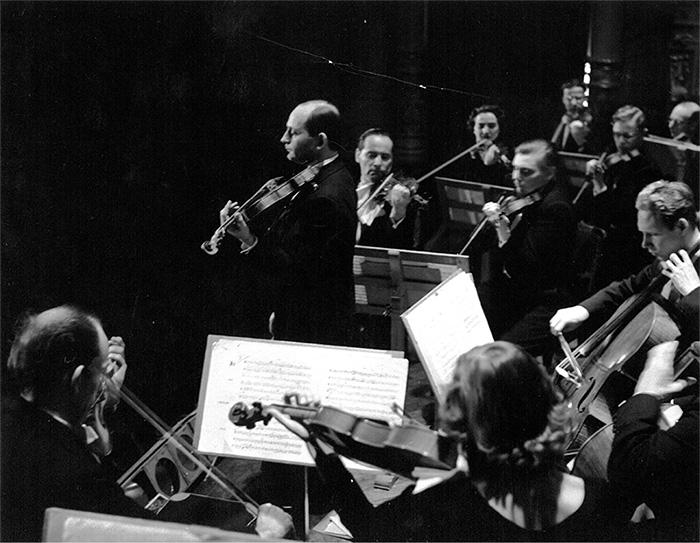

Critique/Review: High Fidelity January 1960
____________
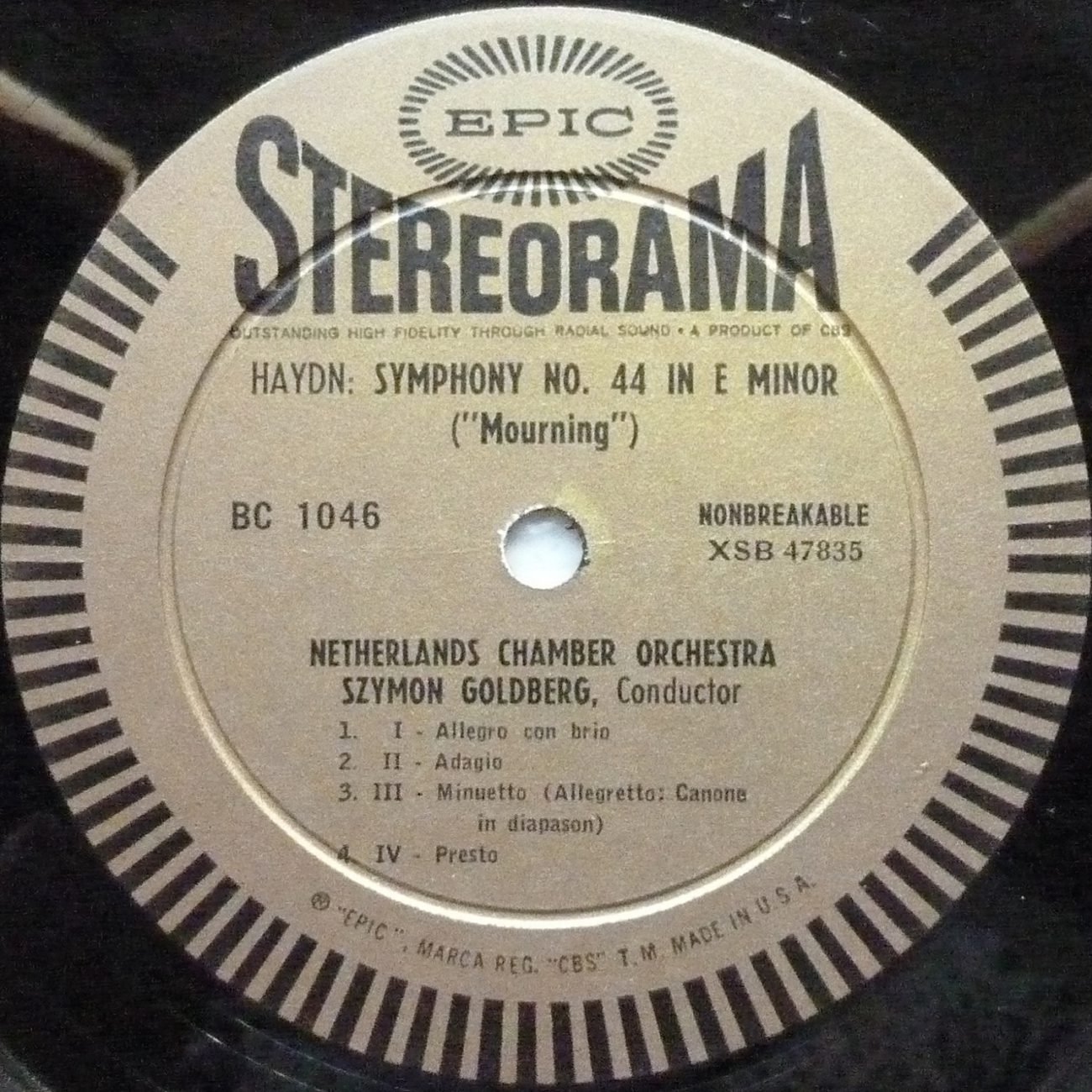

Szymon Goldberg (1909-1993) founded the «Nederlands Kamerorkest» (NKO) in 1955, at the request of the Dutch government and he conducted it until 1979. During the ’70s, David Zinman progressively took over its directorship. In spite of the quality of the Orchestra and of the length of Goldberg’s tenure, the number of commercial recordings is rather small. Live recordings with the NKO are happily found in the Music & Arts boxset CD-1223.
Issued in 1959, the Haydn LP, originally recorded by Philips, wisely couples two of the symphonies of the «Sturm und Drang» period, with a Premiere on disc: Symphony n°57. On the LP, as to the Symphony n°44 («Mourning» or «Trauer»), the Adagio is surprisingly the second movement. and the Menuetto is the third movement. The liner’s notes merely mention that « recent investigations of manuscripts in Germany and Austria would seem to indicate that Haydn may have intended to play them in reverse order».
The recording dates are from the discography by Shuichiro Kawai (2012).



